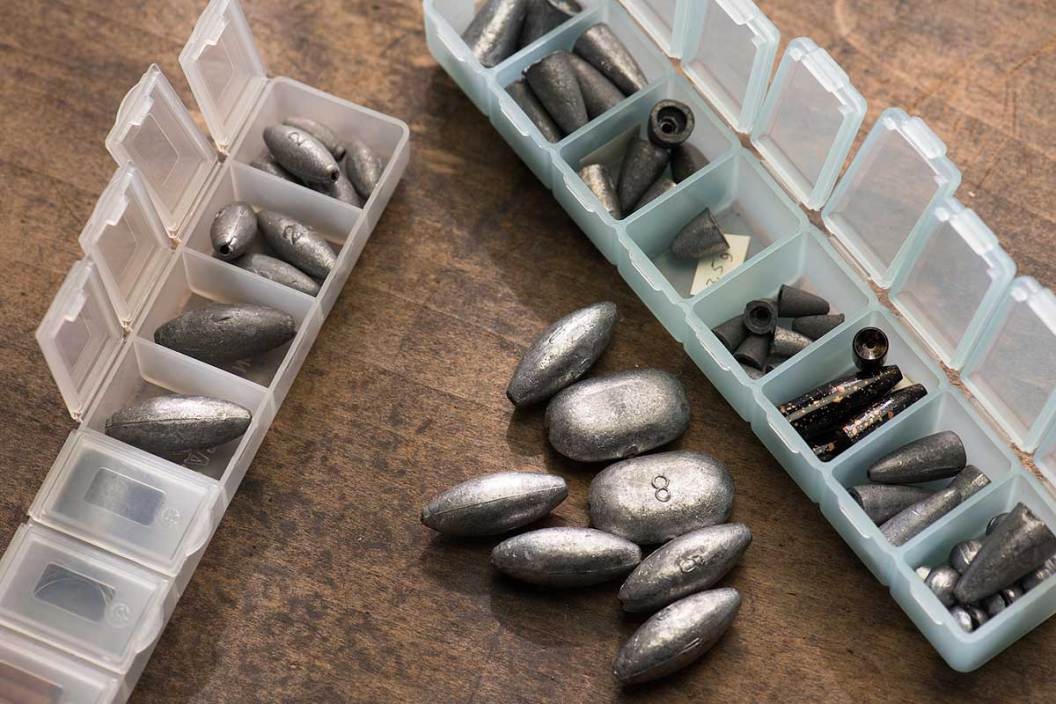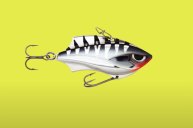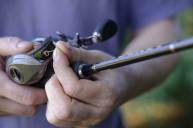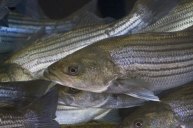Here's all the information about fishing sinkers, the unsung heroes of the fishing tackle box.
We like to spread useful and needed information in the effort to help anglers fully grasp fishing tackle and its many variations. One of the topics that doesn't get enough love, at least in our eyes, is the notion of fishing sinkers, or fishing weights.
Sure, the fishing sinker might be one of the most basic tools, but until someone showed us what they were and how to use them, we may as well have tied a rock to our line.
Basically speaking, sinkers and weights (the terms are used interchangeably) are attached to fishing line to get bait down to the depth that holds fish. They come in a wide variety of shapes, sizes, and weights and each has its own use.
Weights are generally made with lead but brass, tungsten, bismuth, and other materials are becoming more prevalent. They are used for both freshwater and saltwater fishing to keep your bait in the strike zone.
Types of Fishing Sinkers
To help explain, we'll zero in on nine basic types of sinkers available and share some tips on when and where each type of weight works best.
Sinkers might just be the most common piece of fishing tackle there is, but that doesn't mean we know everything about them. Brush up with this info, and you'll be several steps ahead.
Bank Sinkers
The Bank Sinker works well because the tear drop shape makes it perfect for long distance casting and great for fishing a rocky bottom. There's less of a chance of it getting caught or hung up on rocks alone.
Bank sinkers are one of the most basic sinkers there. Since they can be attached to the line directly via its built-in hole, the fisherman can simply thread his or her line through the sinker and tie it off so that it lays directly on the bottom with the hook tied above it to keep their bait in place.
These sinkers take me back to my youth. My dad used to have some lead ingots, a mold, and the means to melt it, so we made our own for years until lead poisoning became a concern.
Worm Weight/Bullet Weight
Simply put, a bullet weight or worm weight resembles a bullet due to its tapered cylindrical shape. They are built to be narrower at one end and wider out at the base, and therefore designed to have the head of your plastic worm bait (or other type) pushed up against it for a snug fit.
One of the best ways to use a bullet weight is to "peg" the weight next to the worm or other plastic bait with a specialized piece of plastic (or just the tip of a broken toothpick) between the weight and the line. This way, the bait can get through thick cover far easier and get into the slop where big fish roam. If an angler doesn't want to peg their weight in this way, there are screw in worm weights that attach themselves to the soft plastic and basically do the same thing.
Slide Sinker
Also known as finesse weights, finesse sliders, and slip bouncers, these are primarily used as live bait rigs for bigger fish like flathead catfish, but are occasionally used for bass fishing. Bullet weights can be used as slide sinkers when they are not pegged, allowing for some distance between the weight and the head of the plastic bait.
The slide sinker is a rig that is popular for several reasons: It allows a catfish angler to pull his line without significant resistance from the sinker. It also allows a fisherman the functional use of a bait clicker (line alarm), which allows a fish to "run" with the catfish bait more easily.
Pyramid Sinker
The Pyramid Sinker is mostly used for weighting a rig for a soft or sandy bottom. This weight casts just as far as a bank sinker, but if the area you are fishing has a rocky bottom, pyramids are not ideal.
The pyramid sinker is similar to the bank sinker, but is much more effective in heavy water such as a strong river current or the churning surf of the ocean.
Drop Shot Sinker
These can come in a teardrop shape or a pencil shape, and they're used for finesse fishing around heavier cover. Teardrop style drop shot weights work well for deeper applications on a softer bottom, but tend to get stuck easily in the rocky crevices. The long, skinny pencil shaped ones have become more popular for their resistance to such snagging.
The real idea behind the drop shot is to rig it in a way that leaves the sinker on the bottom (similar to a bank or pyramid sinker). The main difference is that when twitching the soft plastic bait above it, you'll want to make sure to only lift the bait and try to leave the drop shot weight on the bottom.
No Roll Sinkers
These flat, tear-shaped sinkers are ideal for catfishing in heavy current, because the weights lay level on the bottom to prevent the current from rolling them. The no roll sinker is another form of slip weight that allows the angler to feed line through it and attach the line to a swivel, then follow it with a length of leader line.
No roll sinkers are a classic for catfish fishing on the Mississippi River in the heavy current, but they can also be used to float live or cut bait for massive sturgeon in the northwest. Slide a no roll sinker on your fishing line with a bead or sinker bumper after the sinker. This helps absorb the impact of the sinker sliding into the swivel and protects the knot tied to your hook.
Egg Sinker
As their name suggests, these egg-shaped sinkers are ideal for dragging through mud, sand, or gravel bottoms where it stirs up silt and other debris. That will often attract a fish's attention to the bait trailing the weight. Egg sinkers are great for using with a Carolina rig. Egg sinkers are used in much the same way as no roll sinkers with many good variations used for saltwater applications.
Split Shot Sinker
These sinkers look a lot like a BB, and are probably the most well known of the fishing weights. These little weights are famous for resembling a fish if laid on their side, since the back half of the sinker looks like a fish tail. They can be used for everything from dragging a foot or so in front of a lizard or small plastic worm to setting live bait under a small bobber to drift for panfish.
Split shot comes in a wide variety of sizes. In the northeast, a split shot just above a single hook laden with just one or two salmon eggs is deadly for floating in the current of tributaries where salmon and trout run. In the case of young fishermen, a split shot under a small bobber can keep a worm right in front of every bluegill in the pond and keep a kid quite busy for hours.
Casting Sinker
These bell-shaped sinkers can be attached to a live-bait rig by using a three-way swivel with one eyelet for the main line, the second loop for a drop line attached to the sinker, and the final loop for a leader with a lure or live bait attached.
We used to call these types of weights "swivel sinkers" since they can be attached in that way.
The Final Word
Certainly every tackle box should be equipped with multiple weights and sinkers, whether they be for trolling or for live bait use. Even though lead weights can still be found, more appropriate and environmentally-safe alternatives are out there for everyone.
Whether you are casting for bass, floating live bait for pike, or sending your bait into the surf for stripers, most anglers have some kind of sinker at their disposal to keep their offering in front of the fish. What matters the most is that we continue to share this simple fishing knowledge with those who need to know it, so that they can be more successful and we can pass on the love for the sport.
Looking for a little more or even hot lunch for your hunting blind? Follow my webpage, or on Facebook and YouTube.
NEXT: FISHING JIGS: TECHNIQUES AND TOP BRANDS TO SNATCH UP RIGHT NOW





